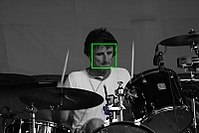Pattern recognition
From Wikipedia, the free encyclopedia
Pattern recognition is a sub-topic of machine learning. It is "the act of taking in raw data and taking an action based on the category of the data".[citation needed] Most research in pattern recognition is about methods for supervised learning and unsupervised learning.
Pattern recognition aims to classify data (patterns) based either on a priori knowledge or on statistical information extracted from the patterns. The patterns to be classified are usually groups of measurements or observations, defining points in an appropriate multidimensional space. This is in contrast to pattern matching, where the pattern is rigidly specified.
Contents |
[edit] Overview
A complete pattern recognition system consists of a sensor that gathers the observations to be classified or described, a feature extraction mechanism that computes numeric or symbolic information from the observations, and a classification or description scheme that does the actual job of classifying or describing observations, relying on the extracted features.
The classification or description scheme is usually based on the availability of a set of patterns that have already been classified or described. This set of patterns is termed the training set, and the resulting learning strategy is characterized as supervised learning. Learning can also be unsupervised, in the sense that the system is not given an a priori labeling of patterns, instead it itself establishes the classes based on the statistical regularities of the patterns.
The classification or description scheme usually uses one of the following approaches: statistical (or decision theoretic) or syntactic (or structural). Statistical pattern recognition is based on statistical characterizations of patterns, assuming that the patterns are generated by a probabilistic system. Syntactical (or structural) pattern recognition is based on the structural interrelationships of features. A wide range of algorithms can be applied for pattern recognition, from very simple Bayesian classifiers to much more powerful neural networks.
An intriguing problem in pattern recognition is the relationship between the problem to be solved (data to be classified) and the performance of various pattern recognition algorithms (classifiers). Van der Walt and Barnard [1] [2] investigated very specific artificial data sets to determine conditions under which certain classifiers perform better and worse than others.
Pattern recognition is more complex when templates are used to generate variants. For example, in English, sentences often follow the "N-VP" (noun - verb phrase) pattern, but some knowledge of the English language is required to detect the pattern. Pattern recognition is studied in many fields, including psychology, ethology, cognitive science and computer science.
Holographic associative memory is another type of pattern matching scheme where a target small patterns can be searched from a large set of learned patterns based on cognitive meta-weight.
[edit] Uses
Within medical science, pattern recognition is the basis for computer-aided diagnosis (CAD) systems. CAD describes a procedure that supports the doctor's interpretations and findings.
Typical applications are automatic speech recognition, classification of text into several categories (e.g. spam/non-spam email messages), the automatic recognition of handwritten postal codes on postal envelopes, or the automatic recognition of images of human faces. The last two examples form the subtopic image analysis of pattern recognition that deals with digital images as input to pattern recognition systems[3][4].
[edit] See also
- Compound term processing
- Computer-aided diagnosis
- Data mining
- EURASIP Journal on Advances in Signal Processing
- List of computer vision conferences
- List of numerical analysis software
- Predictive analytics
- Prior knowledge for pattern recognition
- Pareidolia
- Template matching
[edit] Further reading
- Keinosuke Fukunaga, (1990) Statistical Pattern Recognition, Morgan Kaufmann, ISBN 0-12-269851-7.
- Christopher M. Bishop, (2006) Pattern Recognition and Machine Learning, Springer, ISBN 0-387-31073-8.
- Sergios Theodoridis, Konstantinos Koutroumbas, (2009) Pattern Recognition (4th edition), Elsevier, ISBN 978-1-59749-272-0.
- Phiroz Bhagat, (2005) Pattern Recognition in Industry Elsevier, ISBN 0-08-044538-1.
- Dietrich Paulus and Joachim Hornegger (1998) Applied Pattern Recognition (2nd edition), Vieweg. ISBN 3-528-15558-2
- J. Schuermann: Pattern Classification: A Unified View of Statistical and Neural Approaches, Wiley&Sons, 1996, ISBN 0-471-13534-8
- Sholom Weiss and Casimir Kulikowski (1991) Computer Systems That Learn, Morgan Kaufmann. ISBN 1-55860-065-5
- MOHD SAIFULNIZAM and KRISHNA KUMAR (2008) Budget System, Morgan Kaufmann. ISBN 1-55860-065-5
[edit] References
- ^ C.M. van der Walt and E. Barnard, Data characteristics that determine classifier performance, SAIEE Africa Research Journal, Vol 98 (3), pp 87-93, September 2007.
- ^ C.M. van der Walt, Data measures that characterise classification problems, Master's dissertation, Department of Electrical, Electronic and Computer Engineering, University of Pretoria, South Africa, February 2008.
- ^ Richard O. Duda, Peter E. Hart, David G. Stork (2001) Pattern classification (2nd edition), Wiley, New York, ISBN 0-471-05669-3
- ^ R. Brunelli, Template Matching Techniques in Computer Vision: Theory and Practice, Wiley, ISBN 978-0-470-51706-2, 2009 ([1] TM book)
[edit] External links
- The International Association for Pattern Recognition
- List of Pattern Recognition web sites
- Journal of Pattern Recognition Research
- Multivariate Analysis and Pattern Recognition Team or http://www.mvapr.co.nr
- Recommended Software for Multivariate Analysis and Pattern Recognition or http://www.mvapr.co.nr/techniques.html
- Recommended Texbooks on Multivariate Analysis and Pattern Recognition or http://www.mvapr.co.nr/education.html
- Pattern Recognition (Journal of the Pattern Recognition Society)
- Neocognitron application (C#) to recognize patterns with how to videos are available: here
This article was originally based on material from the Free On-line Dictionary of Computing, which is licensed under the GFDL.


